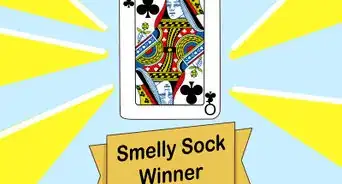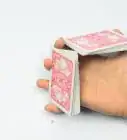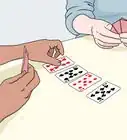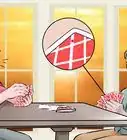wikiHow is a “wiki,” similar to Wikipedia, which means that many of our articles are co-written by multiple authors. To create this article, 37 people, some anonymous, worked to edit and improve it over time.
There are 7 references cited in this article, which can be found at the bottom of the page.
This article has been viewed 273,930 times.
Learn more...
Cheating at card games can involve tricks or simple math. You may have a trick up your sleeve, be able to assess the value of the deck, or have set yourself up for success with a marked or stacked deck. With a little practice and preparation, the odds will be in your favor.
Steps
Stacking the Deck
-
1Search for ideal cards using an overhand shuffle. Place the long edge of the deck of cards along the base of your last three fingers. Your index finger should support the top edge of the deck. Wrap your pinky around to support the bottom edge. Your thumb should be resting on face of the cards, with the cards held vertically, and the back of the cards resting on your fingers.[1]
- Grab the deck with your shuffling hand by placing your thumb in the center of the bottom edge of the cards and your forefinger on the center of the top edge.
- Pull a majority of the cards from the center of the deck into the shuffling hand while gently sliding some of the cards off the top with your supporting thumb to keep them in the palm. Press those cards with your thumb toward the fingers of the supporting hand and drop the the cards from your shuffling hand back onto the top of the deck in the supporting hand.
- Repeat this shuffle. Peel off more cards from the deck in your shuffling hand with the thumb of the supporting hand, until most of the cards are back in the supporting hand. When there are not enough cards left to shuffle in the shuffling hand, drop the rest of the cards on top of the stack in the supporting hand.
- Tilt your supporting hand slightly past vertical so that you can see the face of the cards. Search for the cards you want in your hand.
-
2Float ideal cards to the top of the deck. When you identify a card you would like in your hand, drag the rest of the cards off of it, so that the card you want is at the bottom of the deck. Pull your thumb across the card you want in your hand. Pinch it between your thumb and forefinger to drag it to the top of the deck.[2]
- Continue to shuffle the rest of the cards after floating your card to the top to hide the move.
- Keep the card on top by performing a slip to hold it in place. Firmly place your last three fingers on the top card as you shuffle the others through the deck.
- Use a second card deal to deal yourself the top cards and deal the second card to everyone else. For instance, if you are playing Poker, you will want to have 5 cards on top which set up a good hand for yourself.
- If you are playing a partner game, like Euchre, consider placing more complimentary cards on top of the deck and dealing off the top to your partner as well.
Advertisement -
3Reverse the order of the cards for a bottom deal. If you have placed all your ideal cards at the top of the deck, use the overhand shuffle to reverse the order of the deck and place your cards at the bottom. Grab the entire deck with your shuffling hand and slip one card at a time off the deck with the thumb of your supporting hand until you have gone through the entire deck.[3]
- Now that the ideal cards are on the bottom, you can use a bottom deal to set yourself up with a good poker hand, while dealing to everyone else off the top.
-
4Order the cards to fall in your hand. Cut the deck in half and place each half on the table to perform a table shuffle. Press the bottom half of each deck with your fingers while lifting the inner corners of the deck upward. Control the cards as they fall and shuffle. When you get to the top of the deck, drop the number of cards you need between the two cards you want in your hand so they will fall to you when you shuffle.[4]
- The number of cards between each one you want in your hand will be the number of players minus one, which is you.
- It is better to get too few cards in between on your first shuffle, because you can always shuffle again to add more.
- This is especially useful for a game like Poker where you will be dealing a hand to several people at the table.
Dealing Yourself the Best Cards
-
1Deal yourself the top card by “second dealing” to the rest of the table. Stack the deck with the best cards on top. Hold the deck in the palm of your hand with your thumb on top. Using your thumb, slide the top card at an angle slightly off to the side so that you can grab the corner of the second card with the thumb and forefinger of your dealing hand.
- Continue this process as you deal cards to everyone else, then deal the top card to yourself.
- Practice this move slowly and continue to increase the speed of your deal and decrease the distance you slide the top card as you improve.
- Keep this trick out of the view of the rest of the players by bending your wrist so that the top of the deck of cards tilts slightly toward you. This will utilize the back of your hand to shield the deck of card from the view of the other players.
-
2Deal your hand off the bottom of the deck. Stack the best cards on the bottom of the deck. Hold the deck in the palm of your hand with your thumb on top. Keep the tip of your middle finger poised on the corner of the card on the bottom of the deck. Deal to the other players off the top of the deck. When it is time to deal your own hand, apply slight pressure to the corner of the bottom card, using the middle finger you had poised and ready. Gently push that corner toward the corner diagonally across from it. That corner should press against the palm of your hand, creating a slight bend in the card and separating it from the other cards at the bottom of the deck. Slide the bottom card slightly out from the deck and grab it with your dealing hand.[5]
- It is important to separate the card from the others at the bottom of the deck to be sure that only one card slides and doesn't take some of the others with it, leaving you with a deck which isn't square and potentially giving away your trick.
- Keep the deck slightly tilted with the top of the cards facing the rest of the players and hiding the bottom of the deck and your bending cards.
-
3Stack the deck with the cards in order. Use an overhand shuffle to float the cards you want to the top of the deck, then table shuffle the number of cards between the ones you want in your hand to stack the deck in your favor. If you have stacked the deck with the best cards ordered to fall into your hand, you can deal as you normally would off the top to yourself and everyone else.
- Count the number of players, not including yourself. This is the number of cards you will need to place between the cards you have stacked for yourself on the top of the deck. For instance, if you have four other players in the game, and five cards stacked for your Poker hand on top of the deck, place four cards between each of the five cards you wish to keep for your hand.
- Avoid giving yourself a perfect hand and focus on giving yourself an edge with the best starting hand, so you don't give yourself away.
Counting Cards in Blackjack
-
1Assign a point value to the cards being dealt. Cards 2-6 are considered low value cards. These add one point to your count. 7-9 are neutral cards and do not carry value. 10-Ace are high value cards and subtract a point from your count.[6]
-
2Calculate the point value of the deck with each hand that is dealt. Continue to add and subtract point values for each round dealt from the deck. You will better be able to assess the deck after several hands have been dealt and you have an idea of the value of cards remaining in the deck according to your calculations.[7]
- For instance, if you have 5 players and the cards dealt to each player were: [2, King] [7, 10] [Jack, Ace] [4, 9] [Queen, King] The count for this round would be: [+1, -1] [0, -1] [-1, -1] [+1, 0] [-1, -1] This leaves you with a deck count of: -4.
-
3Practice counting an entire deck of cards. Deal through an entire deck of cards on your own and count the value of each card as you go. If you count correctly, your final count should be zero.
-
4Play your cards right. Dealers have to draw on hands of 12-16, therefore a deck full of low value cards is beneficial to the dealer making it less likely that they will bust, or go over 21 on a hard draw. This means, if you have assessed the deck at a negative point value, it is more beneficial to the dealer, and there are more low value cards left in the deck.[8]
- Do not bet against a dealer on a hard draw with a low value deck.
- You may also benefit from “hitting” or drawing a card if the dealer is showing a face card and you have a hand with a hard draw.
- Make larger bets when you have a high value deck, meaning there are more 10 and face cards left in the deck making it more likely to be dealt a blackjack or 20.
-
5Assess the true count. Most casinos deal several decks at one time. Take your running count of the cards being dealt and divide it by the number of decks left in the dealer's hand or “shoe.” This will give you a better idea of the actual probabilities of being dealt a good hand, or the dealer going bust.[9]
- For example, if your running count is +4, and it appears there are 2 decks left, you would divide 4 by 2, leaving you with +2. This is still a positive count and means you can bet higher on this deal.
Marking a Bicycle Deck
-
1Arrange an order for the suits to be marked on the card. A common system of ordering cards uses the consonants from the word “chased" to order the suits. This code stands for: Clubs, Hearts, Spades and Diamonds.[10]
-
2Use the cluster method to identify the suit. There are five hash marks in the pinwheel under the man at the top corner of each card. Using a fine tipped red or blue sharpie, depending on the color of the deck, color in the hash mark within the pinwheel on the right side which represents the suit of the card according to the “chased” order.[11]
- If the card is a Club you would color in the first hash tag, for Hearts the second, Spades the third and Diamonds the fourth.
- Mark the right side of the card because when they are fanned in your opponents hand in a game like Poker, it is most often the right corner of the card which is showing.
-
3Mark the numerical value in the fan. The fan is the flower shape being held by the man at the top corner of the card. If the flower is completely unmarked, it is an Ace. Use a red or blue pen to mark out the petals on the fan.[12]
- Start marking with the petal to the right of the top/center of the fan, or what could be considered “one o'clock.” Color in this petal to signify a 2. Continue around the flower with 9 being the petal on top of the fan.
- Color in the circle at the center of the fan to identify it as 10. Any face cards should also have this center circle colored in. The circle plus the top/center petal colored in will be a Jack, the circle and the next petal to the right would be a Queen. The center circle plus the third, or horizontal petal would be the King.
-
4Repeat the marks on the opposite corner. Each card has the value flipped on the face of the card, meaning that it can be held in your opponent's hand “upside down” from where you made the mark. Repeat your marks on the opposite corner of the card to be sure it is visible regardless of which way your opponent holds the card.
- This also makes the card look consistent, making it less obvious that the deck is marked.
- Make your marks on a new deck. The color of the deck will fade and you want your marks to fade with it and not be darker than the color on the deck.
Community Q&A
-
QuestionHow should I talk while playing cards?
 Community AnswerMost people just stick to casual small talk, but if you want to try to bluff, just lie to the other players about your hand, "Oh man, this hand stinks, I should really fold," "You're not going to believe this hand I've got," etc.
Community AnswerMost people just stick to casual small talk, but if you want to try to bluff, just lie to the other players about your hand, "Oh man, this hand stinks, I should really fold," "You're not going to believe this hand I've got," etc. -
QuestionShould I mark a blue deck with blue and a red deck in red?
 Community AnswerYes! If you mark a red deck with blue and vice versa then it is clear that it is marked. So when marking it, mark it the color of the deck.
Community AnswerYes! If you mark a red deck with blue and vice versa then it is clear that it is marked. So when marking it, mark it the color of the deck. -
QuestionIs it cheating when someone shuffles the deck face up?
 Community AnswerYes. Part of the point of shuffling is not knowing what order the cards are going to be in.
Community AnswerYes. Part of the point of shuffling is not knowing what order the cards are going to be in.
Warnings
- Do not win too many times in a row or people will get suspicious. People don't like losing every single hand and it's more fun to actually play than it is to have the others quit because they can't win.⧼thumbs_response⧽
References
- ↑ https://www.youtube.com/watch?v=x5tLNHuvf6s
- ↑ https://www.youtube.com/watch?v=T2MM984XHxs
- ↑ https://www.youtube.com/watch?v=x5tLNHuvf6s
- ↑ https://www.youtube.com/watch?v=T2MM984XHxs
- ↑ https://www.youtube.com/watch?v=IWJVt9qXwhU
- ↑ http://www.casinotop10.net/card-counting-guide
- ↑ http://www.casinotop10.net/card-counting-guide
- ↑ https://www.cs.bu.edu/~hwxi/academic/courses/CS320/Spring02/assignments/06/basic-strategy.html
- ↑ http://www.casinotop10.net/card-counting-guide
About This Article
If you want to cheat at card games while dealing, use an overhand shuffle to find a good card and deal it to yourself. To do this, hold the deck in your left hand and take a stack of cards with your right thumb and forefinger. Place them at the front of the deck, then keep repeating this while glancing at the card on the bottom of the stacks. If you see a card you want in your hand, drag the rest of the cards off it and place the card on the top of the deck so you can deal it to yourself. Use a trick called “second dealing” to do this. Just hold the top card of the deck in place with your thumb and keep it half an inch from the edge of the deck. Deal everyone else using the second card in the deck. Then, deal yourself the first card, which should give you a strong starting hand. For more tips, including how to count cards in blackjack, read on!
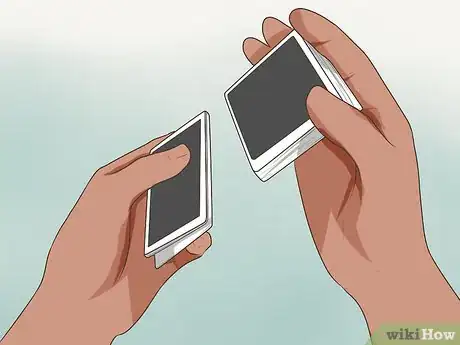





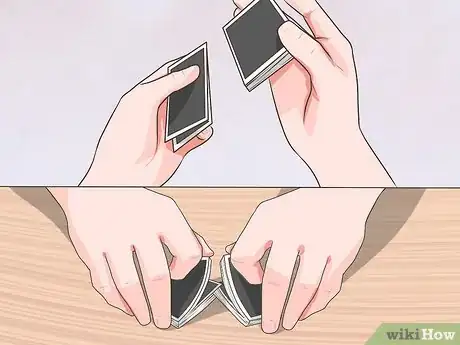




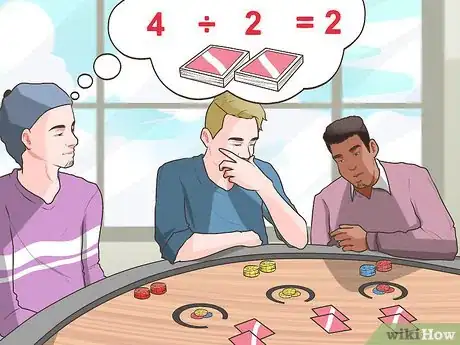




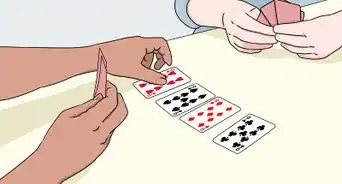
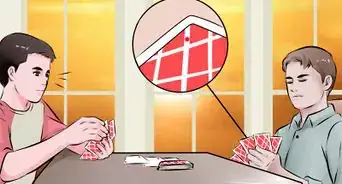


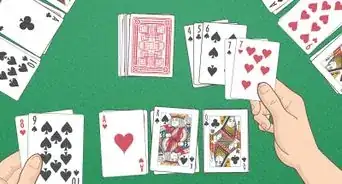
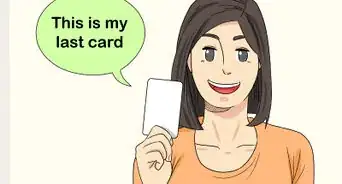
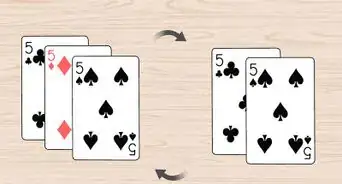
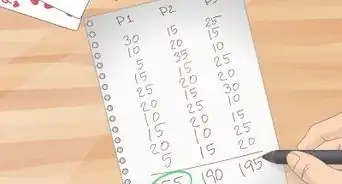
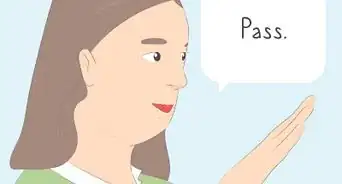

-Step-17.webp)

